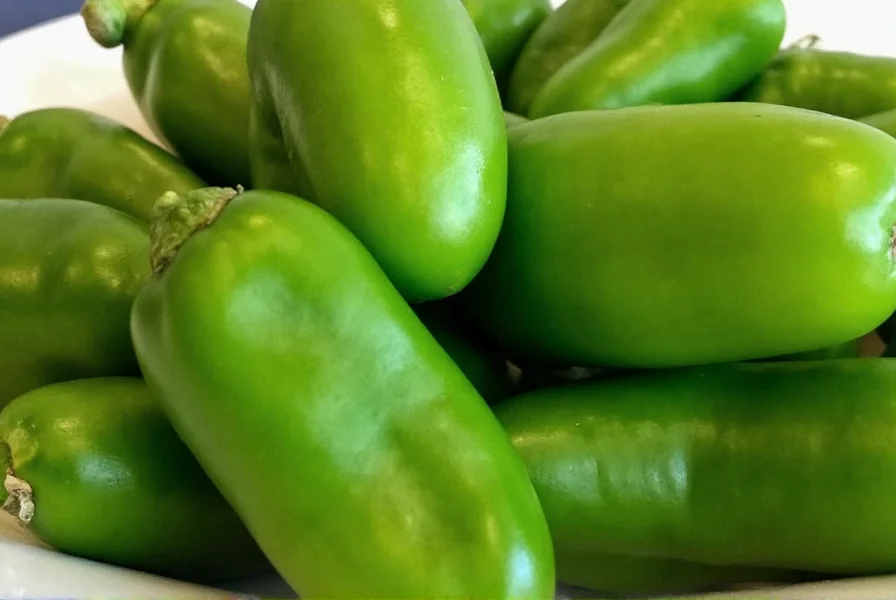Understanding exactly how hot is a jalapeño pepper requires examining the Scoville scale, the measurement system for chili pepper heat. Developed by pharmacist Wilbur Scoville in 1912, this scale quantifies capsaicin concentration—the compound responsible for that burning sensation we associate with spicy foods.
Decoding Jalapeño Heat Levels
While the standard jalapeño pepper scoville units range from 2,500-8,000 SHU, several factors cause significant variation between individual peppers. A jalapeño grown in optimal conditions might register at the lower end of this spectrum, while one stressed by drought or intense sunlight could approach the upper limit.
| Pepper Variety | Scoville Heat Units | Heat Comparison |
|---|---|---|
| Jalapeño | 2,500-8,000 SHU | Moderate heat, culinary versatile |
| Serrano | 10,000-23,000 SHU | 2-3x hotter than jalapeño |
| Habanero | 100,000-350,000 SHU | 15-40x hotter than jalapeño |
| Poblano | 1,000-2,000 SHU | Milder than jalapeño |
Factors That Influence Jalapeño Heat
Several elements determine why are some jalapeños hotter than others. Understanding these helps predict heat levels before biting into one:
- Stress conditions: Peppers develop more capsaicin when experiencing drought, temperature extremes, or nutrient deficiencies
- Maturity: Fully ripe red jalapeños often contain more capsaicin than green ones
- Genetic variation: Different jalapeño cultivars have inherent heat differences
- Seed and membrane concentration: The white pith and seeds contain the highest capsaicin levels

Visual Indicators of Jalapeño Heat
Experienced cooks use visual cues to estimate how to tell if a jalapeño is hot before cutting it:
- Striations (corking): Small brown lines or scars on the skin indicate stress during growth, often correlating with higher heat
- Shape: Thinner, pointier peppers tend to be hotter than plump, rounded varieties
- Color: While not always reliable, deeper green or transitioning red peppers often pack more heat than pale green specimens
Practical Implications for Cooking
Knowing how hot are jalapeños compared to other peppers helps in recipe planning. At 2,500-8,000 SHU, jalapeños provide noticeable heat without overwhelming other flavors—making them ideal for salsas, nachos, and stuffed pepper dishes.
When substituting peppers, remember that removing seeds and membranes can reduce heat by up to 80%. For those sensitive to spice, wearing gloves while handling jalapeños prevents capsaicin transfer to sensitive skin areas.

Handling Jalapeños Safely
Even moderate-heat peppers like jalapeños require proper handling. Capsaicin oil transfers easily to skin and eyes, causing burning sensations. Always:
- Wear disposable gloves when preparing multiple peppers
- Avoid touching your face during preparation
- Wash hands thoroughly with soap and water afterward
- Use separate cutting boards for spicy ingredients
Should you experience skin irritation, apply milk or oil-based products rather than water, which spreads the capsaicin oil.
Common Questions About Jalapeño Heat
How does jalapeño heat compare to other common peppers?
Jalapeños (2,500-8,000 SHU) are significantly milder than habaneros (100,000-350,000 SHU) but hotter than poblanos (1,000-2,000 SHU). They sit in the medium heat range, making them versatile for most palates. Serranos run 2-3 times hotter than jalapeños, while bell peppers register at 0 SHU.
Why do some jalapeños taste much hotter than others?
Variation in jalapeño heat stems from growing conditions (drought or temperature stress increases capsaicin), maturity level (red jalapeños are often hotter), and genetic differences between plants. Even on the same plant, individual peppers can vary significantly in heat intensity.
Can you reduce the heat of a jalapeño pepper?
Yes, removing the white membranes and seeds reduces heat significantly since capsaicin concentrates there. Soaking sliced jalapeños in salt water or dairy products like milk can also extract some capsaicin. Cooking methods like roasting or boiling may slightly reduce heat levels compared to raw consumption.
Do red jalapeños taste different from green ones?
Red jalapeños are simply fully mature green jalapeños. They typically have slightly higher heat levels (toward the upper end of the 2,500-8,000 SHU range) and develop sweeter, fruitier notes compared to the grassier flavor of green jalapeños. The texture also becomes softer as they ripen.











 浙公网安备
33010002000092号
浙公网安备
33010002000092号 浙B2-20120091-4
浙B2-20120091-4